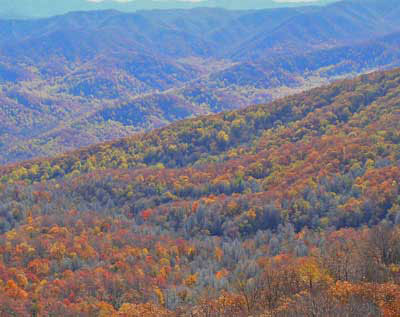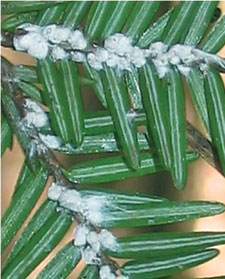Water Quality Meter Helps Monitor the Effects of a Forest Invader
One of the most important causes of the loss of native biota is frequently attributed to invasions by non-native species. One such invasion is that of the devastating exotic forest pest recently established in Kentucky known as the hemlock woolly adelgid (HWA: Adelges tsugae, Hemiptera: Adelgidae). HWA is a xylem feeding insect native to Asia that feeds on all ages, sizes, and species of hemlock (Tsuga spp). While certain hemlock species exhibit some measure of resistance, HWA infestations usually lead to mortality of eastern hemlock (Tsuga canadensis). Furthermore, native predators appear unable to regulate HWA populations in eastern North America. HWA has the capacity to functionally eliminate eastern hemlock from the landscape.
(Side note - I just came back from a trip to the Smoky Mountains and the devastation from this introduced species was evident everywhere.)
Lynne Rieske-Kinney, professor of forest entomology, University of Kentucky, knows all too well the potentially devastating effects of exotic species. They can result in the loss of native species, destroy native habitats, degrade soils, decrease groundwater levels, and even increase the risk of wildfires. Her work is lending a hand towards understanding the effects of HWA and finding ways to stop these effects.
The hemlock woolly adelgid is a Top 20 destructive bug. Recently, it appeared on the UK Invasive Species Working Group’s list of the “Top 14 Invasive Species in Kentucky”. Rieske-Kinney is on the steering committee of the group, which began in 2006, the same year the adelgid was first spotted in Kentucky in Harlan County.
Eastern hemlock is considered a foundation species that dictates microclimatic conditions and strongly influences ecological processes and interactions. It is also an irreplaceable component of riparian zones, particularly within headwater streams.
The loss of eastern hemlock may create a cascade of changes from stand to ecosystem level, including increased nutrient exports, altered transpiration rates, changes in stream macroinvertebrate diversity, loss of microclimates, and community shifts to deciduous species.
Benthic macroinvertebrate community composition is correlated with surrounding forest composition and many species are sensitive to slight changes in stream characteristics. Thus the loss of eastern hemlock from riparian zones has the potential to significantly alter benthic community abundance and functional feeding guild composition. This can have far-reaching ecosystem-level consequences since benthic macroinvertebrates form a vital part of the aquatic food chain as both immatures and adults.
Goal of the Study
The overall goal of a recent study conducted by Rieske-Kinney and Joshua Adkins, Department of Entomology, University of Kentucky, was to characterize the composition and structure of benthic macroinvertebrate communities associated with eastern hemlock dominated headwater streams and comparing that data with deciduous dominated headwater streams.
They also documented chemical and physical properties within these streams in order to correlate stream characteristics with the benthic macroinvertebrate community in order to evaluate the extent to which HWA-induced eastern hemlock mortality impacts stream health.
Research sites are located in eastern Kentucky at Kentucky Ridge State Forest, Natural Bridge State Nature Preserve/Red River Gorge, and Robinson Forest. At each site, three hemlock-dominated headwater streams have been paired with three deciduous dominated streams with similar physical characteristics for a total of eighteen study streams.
A 30-meter segment was established in each study stream approximately 150-m above the confluence. Benthic macroinvertebrates are categorized in order to determine any differences between hemlock and non-hemlock headwater streams.
Stream chemistry is evaluated by collecting two 500 mL water samples concurrent with benthic macroinvertebrate sampling. These samples are taken approximately 2-m downstream from each 30-m reach, placed on ice, and returned to the laboratory to determine nitrate, ammonia, phosphorus, sulfate, and hardness.
Total carbon, total organic carbon, chlorophyll, flow, and width/depth measurements are also being recorded.
In addition, dissolved oxygen, pH, temperature, and specific conductance are being measured directly using a YSI handheld multiparameter instrument. Either the YSI ProDSS or ProQuatro instrument will measure these parameters at one time and log data.
Hemlocks have an important role in the forest community because they regulate stream temperature and chemistry while also controlling sedimentation. Their acidic needles alter the soil around the trees and affect the pH of nearby streams. Invertebrates, including flies, leeches, worms, and crayfish living in the water may be feeding on the needles as well. “In Eastern Kentucky, these hemlocks are often the only evergreen present, so they also provide cover and habitat for a number of different songbird species,” Rieske-Kinney says.
Results
Preliminary results indicate significant differences between eastern hemlock-dominated and deciduous-dominated streams in water chemistry characteristics as well as benthic macroinvertebrate function feeding groups. On average, concentrations of sulfate, total carbon, total organic carbon, as well as conductivity are lower in streams draining eastern hemlock. Further, benthic macroinvertebrate shredders and collectors are more abundant in eastern hemlock-dominated streams.
These results suggest that loss of eastern hemlock from headwater riparian zones due to hemlock woolly adelgid-induced mortality will likely lead to functional changes in headwater stream communities. Rieske-Kinney and her team hope to limit this impact through their research which is still ongoing.

Additional Blog Posts of Interest:
Surface Water Quality Study Near Port-Au-Prince, Haiti
Watershed Partnership Addresses Concerns in a Rural Watershed
Project to Save a Rare Freshwater Species - What is a Wadi?
Lakes Recovering from Acid Rain | Water Quality Improvements are Proof